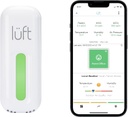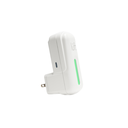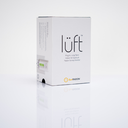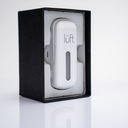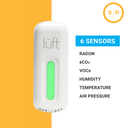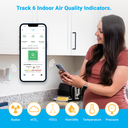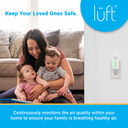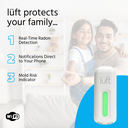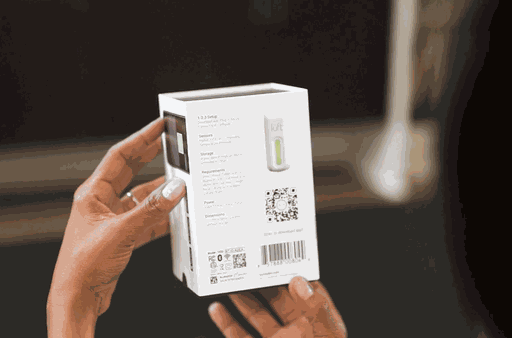Do You Have a Radon Problem?
#1 in Professional Radon Testing,
Now Available for Your Home
Do You Have a Radon Problem?
#1 in Professional Radon Testing,
Now Available for Your Home
lüft is from ![]()
The #1 Choice of Professionals,
Over 10 Million Homes Tested
lüft® Radon and Indoor Air Quality Monitor
Radon:
Know the Risks
The Power of Data in the Palm of Your Hand
Your home’s air quality instantly viewable and downloadable.
The Power of Data in the Palm of Your Hand.
Your home’s air quality instantly viewable and downloadable.
Why lüft?
lüft is from SunRADON - the Worldwide Leader in Radon Measurements

Proven
10,000,000+ homes tested for radon

#1 trusted brand by professionals.

Made in USA
Designed & built in the USA
.
Did you know?
Modern homes are built to be as air-tight as possible – which can contribute to a lack of circulation and air quality. To monitor your air, is to know your air!
Did you know?
Modern homes are built to be as air-tight as possible – which can contribute to a lack of circulation and air quality. To monitor your air, is to know your air!
lüft Measures Your Indoor Air Quality (IAQ)
With lüft, six unique and advanced sensors work together to keep you safe

Radon
Radon is a silent killer. Invisible and odorless, radon is the #7 cause of deaths from cancer in the US.

VOCs
Volatile Organic Compounds (VOCs) are often toxic, can make you feel bad, and can cause long term health issues

eCO₂
High levels of carbon dioxide, eCO₂,can cause issues with mental clarity and interfere with your sleep.

Humidity
Prolonged high humidity promotes mold, which is linked to a number of respiratory health problems.

Temperature
High temperature contributes to mold risk, and like eCO₂ can cause issues with mental clarity and interfere with your sleep.

Pressure
Pressure changes contribute to a variety of ailments including allergies, mental clarity, and mood, as well as radon concentrations
Did you know?
lüft uses the same proven radon detection and monitoring technology as our market leading professional radon monitors, trusted by more radon testing professionals than any other brand!
lüft - Clean design, no clutter
No Batteries
Plugs directly into power outlet
No Wall Mount
No holes in walls, move it with ease
No Cables
No wires or power strips
No WiFi Hub
Connects to your existing WiFi
Did you know?
lüft uses the same proven radon detection and monitoring technology as our market leading professional radon monitors, trusted by more radon testing professionals than any other brand!
Here’s What Our Customers Are Saying...
" I have this monitor in my home and highly recommend it."
"Easy to setup. App works great the first time....made in USA too."
"My #luft from @SunRADON checks my air quality AND measures Radon."
"The best on the market, by far."
FAQ's
 lüft™ Setup and Use Questions
lüft™ Setup and Use Questions
Our plug-in radon detector is more than just a radon sensor – it also measures chemicals, carbon dioxide, temperature, pressure, and humidity. This radon meter provides you with clear visual indicators of your indoor air quality status, and it's smart enough to detect and notify you when levels rise beyond set limits, empowering you to take timely action.
Calibration is not needed for your Lüft™ radon gas detector for home. There are no internal batteries or other components that require servicing either.
Lüft® plug-in radon detector can be plugged directly into any 110V standard wall outlet, preferrably in an upright position.
Lüft® radon measuring device does not require any maintenance. It can be moved around the home to measure different room values.
Yes, to help commercial testing SunRADON offers a convenient, fully automated, web-based dashboard to monitor and manage multiple sensors in commercial or other large buildings. Contact [email protected] for a demo today.
Lüft® home radon monitor uses state-of-the-art solid state technology that does not require maintenance and does not degrade over time.
The lüft™ radon detector will resume operation once power is reinstated, retaining all settings and data on the device for up to 4 years. Upon restarting, it will reconnect to your Wi-Fi, restore custom settings, and resume measuring Indoor Air Quality. Following a power interruption, the initial hourly data reading may be postponed by up to 90 minutes, but ad-hoc readings can be accessed at any time before that.
Certainly. The lüft™ home radon detector is certified by Intertek to meet safety standards UL and CSA 61010-1. This certification involved thorough safety testing conducted by an independent, certified laboratory. Furthermore, our manufacturing facility undergoes quarterly audits by Intertek to ensure ongoing compliance. The device has also been independently tested and found to comply with Proposition 65, also known as the Safe Drinking Water and Toxic Enforcement Act of 1986.
In contrast to our Radon, Temperature, Humidity, and Pressure Sensors, the sensor responsible for measuring VOC and CO2 equivalent operates as a relative sensor. While it precisely detects changes in levels, it doesn't provide absolute level readings. The built-in logic undergoes periodic self-leveling to offset any long-term sensor drift or aging, allowing the sensor to capture minute variations in VOC levels measured in parts per billion. This sensitivity is crucial for detecting air quality deterioration. It's worth noting that most, if not all, VOC sensors in consumer Indoor Air Quality devices operate on a similar principle. For further inquiries, please reach out to your local Indoor Air Professional.
It is recommended to have at least one radon sensor in living room and each of the sleeping rooms.
The lüft™ Monitor provides an indication of your Indoor Air Quality status. A green display signifies that everything is in good condition. If the display is yellow, it indicates that at least one of the 6 sensors has reached or exceeded its Warning threshold. A red display suggests that at least one sensor has reached or exceeded its Alert threshold. If the Nightlight function is activated, the device will show a blue light during the night. For advanced users, customization options allow the adjustment of threshold values, color definitions, and brightness. This includes the ability to select different colors or brightness for each state (Okay, Warning, Alert, Nightlight) and modify thresholds for individual sensors according to your preferences.
To initiate a reset on your device, press the blue button located on the side of the monitor until the LED begins blinking, then release the button. This reset action will erase all sensor and user-specific data from the device, restoring all settings to their default values. If you wish to reconnect to the device, ensure that you remove the device from your phone's Bluetooth list before attempting to reconnect.
The lüft™ digital radon detector is compatible with any 2.4GHz WiFi network. The majority of common "Dual Band" home WiFi routers or hubs support both 2.4GHz and 5GHz. Typically, routers automatically manage the assignment of 2.4GHz or 5GHz, and users can connect to the available network provided by their router. Some routers may offer two networks with different names, and one might include the label "5G." In such cases, it's advisable to select the network without the "5G" label. If uncertain, refer to the router label on the bottom or consult the manual for additional guidance.
You have the option to securely share data from each individual monitor by entering the email address of your trusted Radon or Indoor Air professional within the "share data" section in the individual device menu. Upon activation, your trusted professional can access and monitor your data in real-time. It's important to note that this feature allows for at-will data sharing only, ensuring that your trusted professional has visibility into your data without gaining access to your monitor, mobile app, or phone.
 Radon and Indoor Air Quality
Radon and Indoor Air Quality
Radon is an odorless, colorless radioactive gas. Unlike other noble gases such as Helium and Neon, Radon gas remains closer to the ground. Radon breaks down into solid radioactive elements called radon progeny (e.g., Polonium-218, Polonium-214, Lead-214). Radon progeny can attach to dust and other particles and can be breathed into the lungs. As radon and radon progeny in the air break down, they give off radiation that can damage the DNA inside the body’s cells. Radon is normally found at very low levels in outdoor air and in drinking water from rivers and lakes. It can be found at higher levels in the air in homes and other buildings, as well as in water from underground sources, such as well water.
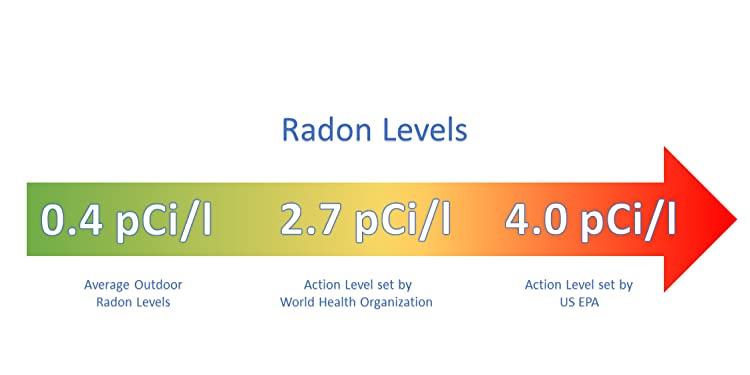
Homes with high levels of radon have been found in every state. In fact, radon levels can vary greatly from home to home--even levels next door can be very different. Radon is measured in picocuries per liter of air (pCi/L), a measurement of radioactivity. In the United States, the average indoor radon level is about 1.3 pCi/L. The average outdoor level is about 0.4 pCi/L. The U.S. Surgeon General and EPA recommend fixing homes with radon levels at or above 4 pCi/L. EPA also recommends that people think about fixing their homes for radon levels between 2 pCi/L and 4 pCi/L.
Visit theEPA websiteor contact a Radon or Indoor Air professional in your area to learn more about Radon..
A Volatile Organic Compound (VOC)is defined as any compound containing carbon that can be readily vaporized, except methane. VOC's, measured in totality of its mixed gases indoor environments from cleaning and disinfecting products, paints, wood preservatives, carpeting, building materials, aerosols, insect repellents, microbial growth, and a host of other sources
At elevated levels, VOC's can cause eye, nose, and throat irritation; headaches, loss of coordination, nausea; damage to liver, kidney, and central nervous system. Some organics (such as Benzene) are suspected or known to cause cancer. Key signs or symptoms associated with exposure to elevated levels of VOC's include eye infections and irritation, nose and throat discomfort, headache, allergic skin reaction, shortness of breath, signs of poisoning, nausea, vomiting, nose bleeding, fatigue, and dizziness..
According to Indoor Air Quality standards such as the WELL Building Standard and the US Green Building Council (USGBC), VOC levels are considered elevated above 300-500 microgram/m3. Depending on the mix of the VOC's and their individual molecular weights that can be translated to about 200 - 450 ppb (parts per billion); OSHA does not generally regulate the total combination of VOC compounds; rather regulates limits for some specific VOC compounds
Carbon dioxide (CO2)equivalents, or short eCO2, are derived from the measurements of the mixed gases, tVOC's, and describe the quality of indoor air in equivalent units of CO2. Traditionally indoor air quality is limited to the measurement of temperature, humidity, and carbon dioxide alone. eCO2, however, follows increasing CO2 levels but also contains information about additional harmful mixed gases and odorous events, while a CO2 sensor detects just the exhaled CO2 from the room’s occupants.
396 ppm (parts per million) was the mean average annualized global outdoor CO2 level reported at the end of August 2013 by NOAA. OSHA states that 1,000 ppm should be used as an upper limit for indoor levels, as a guideline for occupant comfort; a level higher than 1,000 ppm indicates inadequate ventilation. EPA testing recommends Carbon Dioxide levels to not exceed 800 ppm. American Society of Heating Refrigeration and Air Conditioning Engineers (ASHRAE) and the American Society of Testing and Materials (ASTM) suggest indoor levels should not exceed 700 ppm and 650 ppm above outdoor air, respectively. At levels above 2,000 ppm for an extended period of time complaints such as headaches, fatigue, and eye and throat irritation are typical and more widespread.
Relative Humidity (rH) is among the most common of indoor air environmental factors implicated in occupant discomfort. Elevated humidity has been shown to be associated with a worsened perception of Indoor Air Quality. High %rH is also an indicator of conditions favorable to mold and microbial growth.
ASHRAE (American Society of Heating Refrigeration and Air-Conditioning Engineers) recommends a maximum of approximately 56%rH at 80°F and up to approximately 86%rH at 67°F (at standard atmospheric pressure). Clothing, radiant heat and many other factors influence the recommendations of this standard. This is based on their standard Graphical Comfort Zone Method. Per ASHRAE there are not any established lower humidity limits for thermal comfort. However, non-thermal comfort factors such as skin drying, irritation of mucus membranes, dryness of the eyes, and static electricity generation, may place limits on the acceptability of very low humidity environments.
The latest version of the lüft™ app includes a Mold Risk Indicator. The app analyzes the CURRENT condition of temperature and humidity and determines how likely it is to develop mold. The Mold Risk is provided on a 5 level scale from very low to very high risk. Very low risk means it would take more than a year at this condition to develop mold, if any. Very high risk means it would only take less than 3 days to develop surface mold. Note of caution: the device does not measure mold but indicates risk of developing mold. Also, other surfaces in the house; like windows, outside walls; may show mold even at lower risk levels. That is due to the local temperature and humidity index on that window or wall, which can be drastically different than what is measured in open air.
The latest version of the lüft™ app also provides an outside Air Quality Index or AQI. The AQI is a measure of how clean or polluted the outside air is, and what associated health effects might be a concern.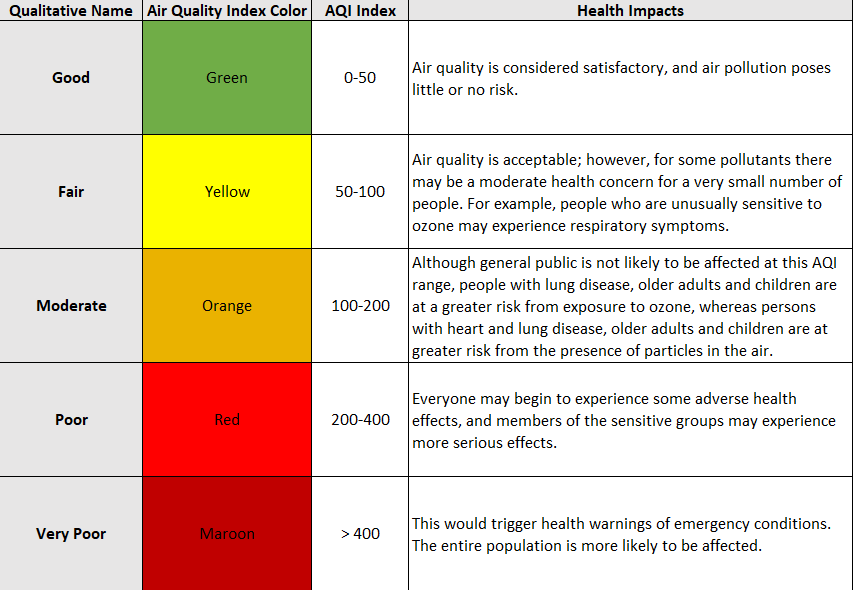
When your lüft™ monitor reports Radon levels above 2pCi/l for extended periods of time, please, contact a Radon Inspection and Mitigation professional. When VOC or eCO2 levels read high repeatedly, contact a certified Indoor Air Quality professional to seek advice or perform additional testing. Improving home ventilation will temporarily mitigate the health concerns but does not address a potential underlying issue as to why levels read high
Essential Add-ons and Accessories

To install this Web App in your iPhone/iPad press
![]() and then Add to Home Screen.
and then Add to Home Screen.

